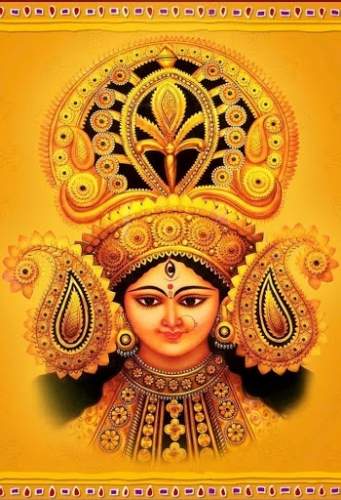The festival of Navaratri chiefly celebrates Durga and Nava Durga. But people across the country also honour local or regional forms of the goddess, especially on Dussehra

Dussehra or Vijiayadashami is one of the most important autumnal festivals in India. It marks the end of the nine-day Navratri celebrations as well as the five day Durga Puja festivities.
It is also believed to be the day that Lord Rama defeated King Ravana and his army in a long battle between the forces of good and evil.
It is for this very reason that the day is called Vijay Dashami (the day of victory). It is also the day when Goddess Durga clashed with Mahishasura’s army and slayed the buffalo demon once and for all.
It should be noted that even though Dashami and Dusshera follow different rituals, they bear the same message — that of victory of good over evil. On this day, Ramlila performances are also organised, especially in the northern part of the country, during which, effigies of Ravana, Meghnad and Kumbhakaran are burnt, so as to represent victory of good over bad. People depict the life and glory of the righteous Lord Rama through ballads and plays.
The common theme that runs through both festivals is the triumph of good over evil.
In many places in Northern India, effigies of Ravana are burnt to symbollically celebrate the demolition of eveil inside human beings and artists too take part in a play based on Tulsidas' Ramcharitmanas in the famed Ramlila.
While the word Dussehra comes from the two Sanskrit words dasha (symbolising the ten heads of Ravana) and hara, which means 'to defeat', burning the effigies of Ravana, Kumbhakarna and Meghnad is supposed to abolish the evil inside human beings.
In the eastern part of India where Vijayadashami will be celebrated the next day, it will be marked through sindur khela among married women and the immersion of Goddess Durga along with her children Lord Ganesha, Lord Kartikeya, Goddess Saraswati and Goddess Lakshmi. People wish each other Subho Bijoya following the immersion of the idol.
Religious grandeur in West Bengal
Durga Puja or Dussehra in West Bengal gives the state its real identity. The festival transforms the entire state into a dynamic activity hub. The festival holds great importance in the lives of every citizen of West Bengal. Various theme based pandals are created where amazing idols of Goddess Durga along with other deities including, Ganesh, Laxmi and Saraswati are worshiped for 5 days. People desperately wait for this event from long. Such eagerness and excitement of worshiping Goddess Durga can nowhere be seen in India.
With garba in Gujarat
In the colorful state of Gujarat, Dussehra is celebrated as Navratra. Garba is the prime ingredient of this festival in this state, which is the very famous folk dance of Gujarat. It is the main attraction of the festival that brings people close and make them tune on the folk songs with multi-colored sticks. Garba is played throughout the night after worshiping Goddess Durga. For playing Garba, men and women wear traditional attires that are Lehnga Choli for women and Kedia for men.
Spectacular Ram Leela in Delhi
Delhi celebrates Dussehra as the defeat of Ravana by Lord Rama. Temples are decorated wonderfully on this eve and Ram Leela is one of the greatest appeals of the city. Idols of all three demons, including Ravana, Meghanad and Kumbhakaran are set on fire at various locations of the city. Most of the people in this city keep fasting of 9-days. Watching Ramleela - a theatrical version of the Ramayana in Delhi is a beautiful experience. There are many places in Delhi, where Pandals of Goddess Durga are created.
Kulasekarapattinam Dasara in Tamil Nadu
Kulasekarapattinam Dasara is a different way of celebrating Dussehra in Tamil Nadu state of India. The festival goes alive during 10-days Dussehra festival in state. The festival is celebrated around the Mutharamman Temple, which is a hotspot of music, dance and drama and showcases an amazing range of vibrant costumes. An exclusive aspect of this festival is a trance dance in which people swing in unique costumes on the lively beats of thara thappattam
Madikeri Dasara in Karnataka
Every region of Karnataka celebrates Dussehra in a special way. A parade of ten mantapas (floats), each reaching a height of around 25 ft, makes up the main event at Madikeri Dasara. Every Dasara float has a large stage, on which life-sized idols rotate and move, depicting a mythological story (mostly related to Durga and Nava Durga).
In Mangaluru, young boys and men paint their faces and bodies to look like a tiger. Dressed as tigers, they dance and perform acrobatic stunts in honour of the local goddess Sharada (a form of Saraswati). Known as Hulivesha (in Kannada, huli is ‘tiger’ and vesha is ‘dress’), this dance is a tribute to the goddess from her vahana-the tiger!
Dashain in the North-East
In Sikkim, Meghalaya and Mizoram, the festival is celebrated as Dashain by Nepal’s Gorkha community, who came to India during the British rule. At the time of ghatasthapana, instead of seven or nine types of seeds, the people only sow jamara (barley) seeds. Linge Ping, a traditional bamboo swing (rarely seen or used nowadays), is specially built for Dashain. Interestingly, children and grown-ups must stand on it, not sit, to make it swing. On the festival’s seventh day, the people observe ‘phoolpatti’, a unique practice where leaves from nine types of plants are picked and worshipped. These are immersed, along with the jamara shoots and the idol, on the last day.
Dussehra celebrations show how much the country’s people adore and respect the goddess. Be it as a demon-slayer, universe protector or boon giver, Durga is loved and worshipped by many.